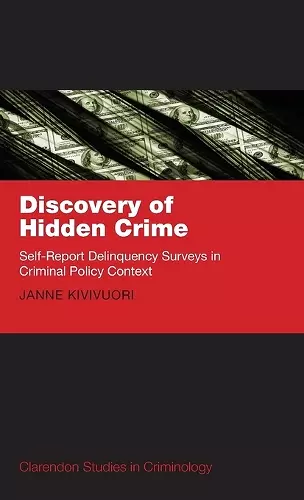Discovery of Hidden Crime
Self-Report Delinquency Surveys in Criminal Policy Context
Format:Hardback
Publisher:Oxford University Press
Published:13th Oct '11
Currently unavailable, and unfortunately no date known when it will be back

Discovery of Hidden Crime presents a history of the self-report crime survey as a method of criminological inquiry, describing how it was born within a distinct moral framework by pioneers out to show that crime was very prevalent and, therefore, normal. This books recounts how, during the 1930s and 1940s, a handful of US criminologists discovered the method of the self-report delinquency survey - a method used to ask people directly about their crimes. Previously, criminologists had to rely on official statistics produced by the police and other control authorities; their studies were therefore constrained by the 'official control barrier', which perpetuated the notion that crime was linked to the lowest social strata and/or to psychological abnormality. By confronting the domination of psychiatrists and psychologists in the study of crime, criminologists began to challenge the punitive attitudes of society; thus, exposing the so-called white collar offenders and alerting people to see crime as something that could also be found among the middle and upper classes. Expounding both the history of that discovery and its implications for criminological work, past and present, this book offers a fascinating perspective on how criminology has developed, and how it continues to advance amid the twin pressures of facts and policy goals. This is an open access title. It is available to read and download as a free PDF version on Oxford Academic and is made available under a Creative Commons Attribution-Non Commercial-No Derivatives 4.0 International licence.
Janne Kivivuori's Discovery of Hidden Crime is one of the best social histories of criminology in print. It focuses on the scientific, cultural, and political origins of the self-report delinquency survey, but in many ways is a broader history of criminology itself, a sociology of criminological knowledge... The book even has a plot line. It starts with a mystery-how can we break into that locked room to discover the amount of hidden crime?; it chronicles the long search for the tools to pry open the lock; and it shows how criminologists finally broke into the room where the treasure lay... Above all, this book is valuable as a social history of criminology, one that will, I hope, stimulate courses in this field. * Nicole Rafter, Theoretical Criminology *
ISBN: 9780199639199
Dimensions: 217mm x 135mm x 31mm
Weight: 388g
218 pages